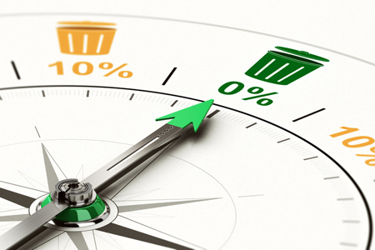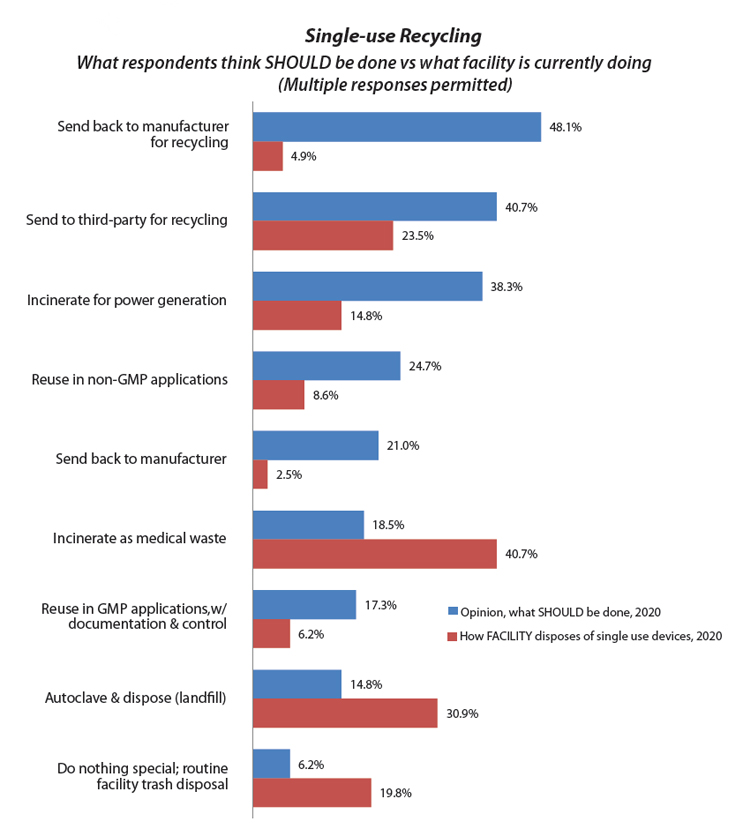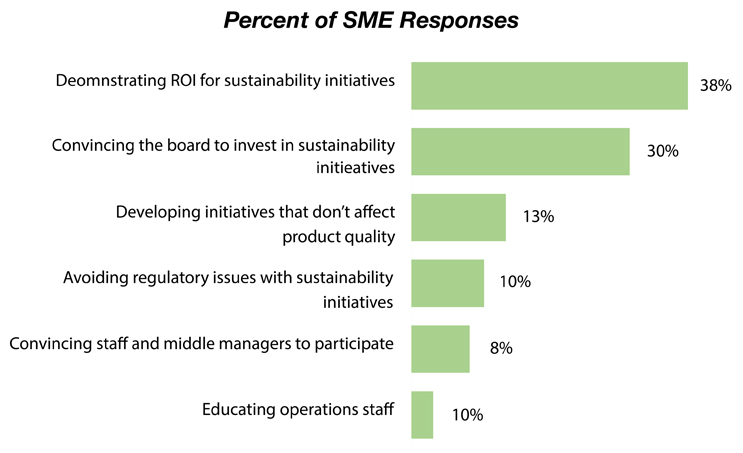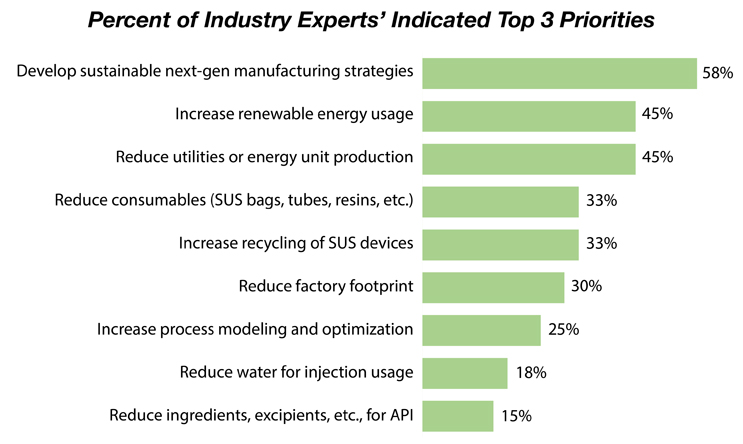Survey Results Show What Could Finally Make Sustainability Stick
By Doug Nissinoff, senior research and strategy associate, BioPlan Associates Inc.

The World Commission on Environment and Development in 1980 defined “sustainable development” in their Brundtland Report for the United Nations as a model that “meets the needs of the present without compromising the future”.1 This definition requires us to ask: "Are we considering our actions today in terms of whether are making the world more or less viable for future generations?”
A dilemma today between biopharma and the growing interest in sustainability is that biological production is highly regulated. The extreme demand for safety and quality of the product and the zero-tolerance for mistakes means that the product comes first. Yet, as seen in our “20th Annual Report of Biopharmaceutical Manufacturing and Production,” industry managers’ interest in sustainability, waste disposal, and responsible stewardship has grown significantly over the past 14 years.2
Understanding Process Efficiency In Sustainable Biopharma
Pietro Perrone, a senior process engineer at Rentschler Biopharma Inc. and a member of ISPE's Community of Practice – Disposables Steering Committee, emphasizes the direct correlation between sustainability and process efficiency.3 He says that the primary step in the sustainability hierarchy of “reduce, reuse, recycle” is “reduce.” The quantification of the benefits from improved process efficiency, particularly reductions in usage, is crucial. This is because leaders in the biopharma and bioprocessing sectors will invariably favor initiatives that not only enhance sustainability but also cut costs.
The Evolution Of Waste Disposal Concerns In Biopharma
Historically, the biopharma sector has taken a shifting stance on waste disposal. In 2009, the sentiment was that waste disposal did not play a significant role in decisions related to the adoption of single-use systems.2 Unfortunately, this situation hasn't changed much over the years. What has shifted, though, is the attitude about what should be done. Interestingly, data on this portrays a paradox: as the industry's dependence on single-use systems grew, there was a greater professed interest in doing the right thing around waste disposal.
Recycling In Biopharma: Intentions Vs. Actions
In 2013, a notable 70% of industry professionals expressed the need for recycling initiatives. Yet the figures told a different story with merely 35% actively engaged in recycling efforts. Alarmingly, 76% continued to depend on incineration or landfill disposal techniques. Then in 2020, the interest in recycling skyrocketed to 89%. Virtually everyone wanted to do the right thing. However, the irony lies in the actual recycling rates, which plummeted to 25%.
Figure 1: Single-use recycling: respondents’ desires for disposal vs. actual disposal process (2020 data)

Source: 20th Annual Report of Biopharmaceutical Manufacturing and Production. April 2023, BioPlan Associates Inc.
Over the past decade in our annual report, there has been a notable shift in vendor perspectives regarding recycling programs associated with single-use products. In 2012, vendor satisfaction with recycling programs was relatively low, with only 8.2% expressing that they were "very satisfied" or "satisfied." Moreover, just 31.5% considered the recycling programs as a "very important" or "important" factor in their selection process. A year later in 2013, there was a modest uptick: satisfaction rose to 11.5%, and the importance of recycling programs in the selection process increased to 46.4%. By 2023, the transformation was evident. Vendor satisfaction had nearly tripled from its 2012 figure, reaching 29%, and a significant 51.9% rated recycling programs as crucial in their decision-making. This progression underscores an evolving industry sentiment and emphasizes the growing value placed on sustainable practices in biopharma supply chains.
Leadership At The Heart Of Sustainability
In the biopharma sector, where regulators, the FDA, and EMA govern production and quality, sustainability initiatives are often difficult to balance against the need for product quality. Executives also must keep shareholders and internal stakeholders happy.
Managing that balance creates major challenges for leaders. At a June 2023 CDMO summit in Copenhagen, BioPlan surveyed 44 global CMC consultants regarding the challenges they saw leaders facing when advocating for sustainable initiatives.
The single most daunting challenge is “demonstrating an ROI,” followed by the related “convincing board to invest in sustainability initiatives.”
Figure 2: No. 1 challenge bioprocessing leaders face when advocating for sustainability

Source: BioPlan’s survey of 44 biopharma CMC consultants at a CDMO summit in Copenhagen, June 2023
Successful Sustainability Requires The Ability To Measure Progress
Achieving sustainability requires positive outcomes and the ability to measure success. Real sustainability is not just about incremental improvements, like, for example, implementing a recycling program, a public relations campaign around planting trees, or installing solar panels. It is about changing mindsets, and that requires organizational change.
To accomplish this, the data suggest that sustainability will occur in biopharma segments when the focus includes:
- revenue-positive outcomes or, in other words, profitability, and
- the ability to measure initiatives’ results like revenue, productivity, and efficiency.
Crucial Mandates For Chief Sustainability Officers
The role of a chief sustainability officer (CSO) is undeniably intricate and pivotal in navigating sustainability. Often, however, their role is more like that of a manager, overseer, monitor, and compliance reporter. According to a 2023 HBR study, the CSO’s responsibilities included:
- ensuring regulatory compliance
- environmental, social, and governance (ESG) monitoring and reporting
- overseeing the portfolio of sustainability projects
- managing stakeholders’ relationships
- building organizational capabilities
- fostering cultural change
- scouting and experimenting
- embedding sustainability into processes and decision-making.
These responsibilities have little to do with organizational change. Especially in complex and unique biomanufacturing environments, these roles are unlikely to motivate individuals toward a sustainability mindset. In fact, it’s possible that in such a regulated environment, adding more sustainability regulations will just kill the bioprocessing staff’s desire to do the right thing. We saw that demonstrated in the results of the annual report.
Simply monitoring and reporting on ESG factors won’t help ensure that sustainability becomes more deeply embedded within the organization's decision-making.
Survey Results: ‘Make Sustainability About Profitability, Not Recycling Programs’
Let’s accept that sustainability initiatives on their own are more likely to fizzle out than succeed. Another path is emerging. Experts seem to agree that reverse engineering the problem — with a focus on optimizing processes and making them more efficient — will make sustainability initiatives more sustainable.
Efficiency and profitability are key to long-term success. Figure 3 shows how the experts responded to questions about the most important priorities for achieving bioprocess sustainability.
Recycling and reducing usage may be easy to do and to measure, but these incremental activities may not contribute substantially to the long-term change required for real sustainability.
Figure 3: Most important priorities for achieving bioprocess sustainability

Source: BioPlan’s survey of 44 biopharma CMC consultants at a CDMO Summit, Copenhagen DK, June 2023
The Financial Lens On Sustainability
In the ever-evolving landscape of sustainability, there's a pivotal shift in the motivations propelling its adoption. While ethical considerations and corporate responsibility remain foundational, the economic narrative is gaining ground. Companies increasingly recognize the financial advantages tied to sustainable practices.
The optimization of energy consumption, for instance, isn't merely an environmental win. It directly translates to substantial cost savings. Furthermore, sustainable strategies can bolster efficiencies, foster innovation, and even carve out new revenue streams. The added allure of potential market differentiation and brand enhancement further amplifies the economic rationale. The economic incentives intertwined with sustainability aren't just complementary benefits, they're often the driving force, overshadowing even the noblest corporate ethos. This intertwining of fiscal prudence with environmental responsibility underscores a maturing understanding of sustainability – one where profitability and planet-friendly practices coexist.
References:
- World Commission on Environment and Development (WCED). (1987). "Our Common Future" (also known as the Brundtland Report). United Nations.
- 20th Annual Report of Biopharmaceutical Manufacturing and Production. April 2023, BioPlan Associates, Inc. www.bioplanassociates.com/20th
- Perrone, Pietro. (2015). “What About the Environmental Impact of Single-Use Technology on Sustainability?” Rentschler Biopharma, Inc. & ISPE's Community of Practice – Disposables Steering Committee.
- ISPE’s Disposables Community of Practice. (2023). "Waste Management in Biopharma: A Study."
About the Author:

Doug Nissinoff is trained and educated in the biotech/pharma sector. He holds an M.S. in biotechnology from Georgetown University. He works with BioPlan Associates and serves as managing director of Intelligence Ventures, emphasizing investments in AI and healthcare. He has extensive experience in global executive consultancy with a focus on international expansion and commercialization in the biotech, pharma, and medical technology sectors.

